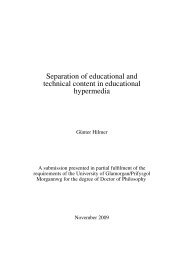framework for the implementation of a virtual design studio model in ...
framework for the implementation of a virtual design studio model in ...
framework for the implementation of a virtual design studio model in ...
Create successful ePaper yourself
Turn your PDF publications into a flip-book with our unique Google optimized e-Paper software.
The focus group methodology was conducted to identify students' perspectives <strong>of</strong> <strong>the</strong><br />
current teach<strong>in</strong>g and learn<strong>in</strong>g practices <strong>in</strong> <strong>the</strong> <strong>design</strong> courses <strong>of</strong>fered <strong>in</strong> <strong>the</strong> architecture<br />
school <strong>of</strong> <strong>the</strong> UAEU. The aim <strong>of</strong> this <strong>in</strong>vestigation was first to ga<strong>in</strong> a prelim<strong>in</strong>ary<br />
understand<strong>in</strong>g <strong>of</strong> <strong>the</strong> difficulties, approaches, attitudes, perceptions, and motivation<br />
related to <strong>the</strong> learn<strong>in</strong>g <strong>of</strong> <strong>design</strong> <strong>in</strong> architecture schools. Second, <strong>the</strong> <strong>in</strong>vestigation was<br />
<strong>design</strong>ed to assess <strong>the</strong> extent to which <strong>the</strong> students would be <strong>in</strong>terested <strong>in</strong> <strong>the</strong> use <strong>of</strong><br />
sophisticated technology <strong>in</strong> <strong>the</strong> teach<strong>in</strong>g and learn<strong>in</strong>g environment <strong>in</strong> <strong>the</strong> UAE<br />
architecture education schools <strong>in</strong> order to achieve effective learn<strong>in</strong>g. The study was<br />
conducted <strong>in</strong> <strong>the</strong> UAEU because it is <strong>the</strong> largest university <strong>in</strong> UAE, and because o<strong>the</strong>r<br />
universities that house an architectural school or department follow a similar<br />
educational system. In addition to <strong>the</strong> focus group <strong>in</strong>terviews with <strong>the</strong> UAEU students,<br />
unstructured <strong>in</strong>dividual <strong>in</strong>terviews with lecturers from this university and <strong>the</strong> AUS were<br />
carried out.<br />
These <strong>in</strong>terviews were conducted after <strong>the</strong> focus group session. The purpose <strong>of</strong> <strong>the</strong><br />
<strong>in</strong>terviews was merely to validate <strong>the</strong> <strong>in</strong><strong>for</strong>mation collected from <strong>the</strong> students. For this<br />
reason, <strong>the</strong> <strong>in</strong>terviews took <strong>the</strong> <strong>for</strong>m <strong>of</strong> casual conversations whenever <strong>the</strong> researcher<br />
found an opportunity to talk to a lecturer <strong>in</strong> <strong>the</strong> UAEU after one <strong>of</strong> <strong>the</strong> focus group<br />
sessions. AUS lecturers were <strong>in</strong>terviewed to ascerta<strong>in</strong> that <strong>the</strong> learn<strong>in</strong>g environment <strong>in</strong><br />
this university was not disparately different from that <strong>of</strong> <strong>the</strong> UAEU. For more details<br />
about this see appendix A.<br />
F<strong>in</strong>d<strong>in</strong>gs from <strong>the</strong> <strong>in</strong>terviews<br />
To summarise, <strong>the</strong>re were three major issues that persistently emerged dur<strong>in</strong>g <strong>the</strong><br />
group discussions: First, <strong>the</strong> differences between students’ preferred methods <strong>of</strong><br />
learn<strong>in</strong>g and teach<strong>in</strong>gs methods employed by <strong>the</strong> lecturers; second, <strong>the</strong> contribution <strong>of</strong><br />
prior knowledge towards learn<strong>in</strong>g and understand<strong>in</strong>g; and third, learn<strong>in</strong>g methods <strong>of</strong><br />
students. The issues are discussed below<br />
Preferred learn<strong>in</strong>g methods<br />
Three ma<strong>in</strong> problem areas came under constant discussion and were cont<strong>in</strong>uously<br />
referred to with regard to learn<strong>in</strong>g methods, learn<strong>in</strong>g preferences and motivation. These<br />
problems were brought up by both students and lecturers. Students <strong>in</strong>dicated that<br />
present methods <strong>of</strong> teach<strong>in</strong>g are not positively contribut<strong>in</strong>g to understand<strong>in</strong>g <strong>the</strong><br />
subject. It was found from <strong>the</strong> <strong>in</strong>terviews that effective learn<strong>in</strong>g on <strong>the</strong> part <strong>of</strong> <strong>the</strong><br />
students can be improved by us<strong>in</strong>g <strong>the</strong> follow<strong>in</strong>g methods:<br />
Interactive and Simulated Real World Imitation: Students seemed to be critical <strong>of</strong> <strong>the</strong><br />
lecture method, <strong>the</strong> current method <strong>of</strong> teach<strong>in</strong>g. They have difficulty learn<strong>in</strong>g through<br />
just one sense, <strong>the</strong> sense <strong>of</strong> hear<strong>in</strong>g. It was found that most students favoured learn<strong>in</strong>g<br />
through real time imitation. They believed <strong>the</strong>y can understand better through imitat<strong>in</strong>g<br />
real life projects characterised by a <strong>design</strong> process <strong>in</strong>volv<strong>in</strong>g a full team work<strong>in</strong>g<br />
toge<strong>the</strong>r <strong>in</strong> one project. When one <strong>of</strong> <strong>the</strong> fourth level students <strong>of</strong>fered a summary <strong>of</strong><br />
<strong>the</strong> discussion about <strong>the</strong> topic by say<strong>in</strong>g “it <strong>of</strong>fers us <strong>the</strong> experience which we cannot<br />
get from read<strong>in</strong>g books”, <strong>the</strong> o<strong>the</strong>r students <strong>in</strong> <strong>the</strong> group expressed an overwhelm<strong>in</strong>g<br />
85



